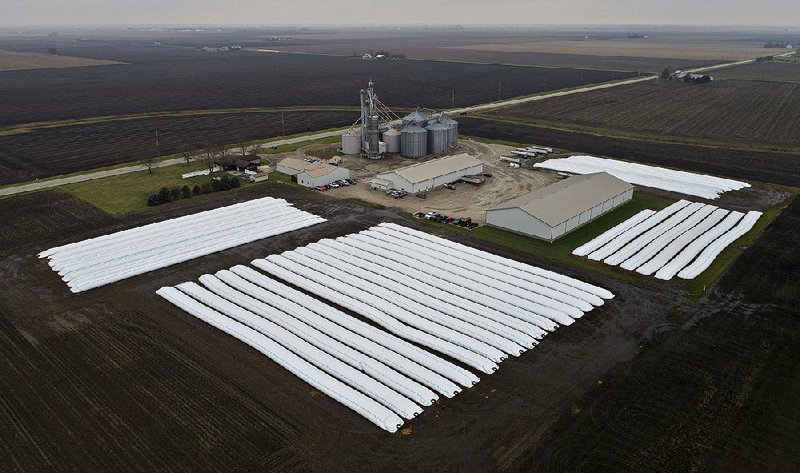WASHINGTON -- President Donald Trump's escalation of the trade war with China without a concrete plan to aid farmers threatens to worsen the rising stockpiles of U.S. crops such as soybeans and depress commodity prices even after the current dispute is resolved, raising concern among analysts and some lawmakers.
The Trump administration is signaling that the aid package it's assembling would make payments to farmers based on their current crop production.
"This is serious," said Joseph Glauber, former chief economist for the U.S. Department of Agriculture. "It's worrisome to me that you could set prices that would really influence planting decisions, potentially distorting production."
The administration's signals on trade aid have sown confusion and the sense among some economists that a $15 billion or even $20 billion program with major ramifications for agriculture and commodity markets is being improvised on the fly.
Just weeks ago, Agriculture Secretary Sonny Perdue said there were no plans for trade aid in addition to assistance provided last year. Trump then announced, in tandem with new tariffs on China announced last week, that he would seek to offset the lost demand by bolstering purchases of domestic farm products for humanitarian aid. After criticism that the humanitarian program was unrealistic, Perdue said Wednesday that the new aid would mirror the earlier assistance.
Last year's $12 billion trade-assistance program broke with more than two decades of American agricultural policy, which has tied payments to farmers' historic plantings rather than current production. Disparities in the way crops were treated also provoked criticism, particularly a $1.65 per bushel rate for soybeans compared with 1 cent per bushel for corn.
Farmers are crucial part of Trump's political base. He dominated rural America with a 28 percentage-point advantage over Democrat Hillary Clinton in 2016, according to exit polls.
Farm-state lawmakers have been lobbying the administration behind the scenes to address disparities in this year's payments, according to several congressional aides. Corn growers started a public campaign Wednesday to address grievances over last year's payment rate.
Last year's trade-assistance package was announced near the end of the growing season, when it was too late for farmers to alter their production plans. This time, much of the crop has yet to be planted. As of Monday, only 30% of the corn crop had been planted and 9% of the soybean crop, according to the Agriculture Department.
"Because of planting, there probably isn't a worse time for the president to go out and announce a payment to farmers," said Jonathan Coppess, former head of the U.S. Farm Service Agency, which oversees farm subsidies.
A rainy spring in the Midwest has already created an incentive to shift away from corn to soybeans, which can be planted later in the year, said Coppess, now an agricultural policy professor at the University of Illinois.
"If you're in Illinois or Indiana or Iowa watching it rain, then the potential of a large soybean payment could be a real factor," Coppess said. "Last year, U.S. farmers planted close to 90 million acres to corn and almost another 90 million to soybeans, and many farmers in the Midwest rotate on a 50/50 basis between the two crops, so the impact could be millions of acres and hundreds of millions of bushels."
Chad Hart, a crop markets economist at Iowa State University, said the mere announcement of the trade aid will shape farmers' planting decisions, even if the administration doesn't provide details of its plan or payment rates soon.
"Right now I think a lot of farmers out there would be saying, 'I know the payments last year were heavily weighted toward soy. I'll bet the new program will look an awful lot like the old program, and I'll plant soy then,"' Hart said.
The standoff with China over trade is compounding the financial strain of five years of falling commodity prices and losses from spring flooding. American farm income dropped 16% last year to $63 billion, about half the level it was as recently as 2013.
Since Congress passed the Freedom to Farm Act in 1996, U.S. farm subsidies had moved away from payments based on current crop production in an effort to avoid distortions in agriculture markets. Instead, subsidy payments are based on an average of how many acres a farmer has planted of an individual crop in previous years and crop yields for the area.
The South Dakota congressional delegation wrote Perdue a letter on Thursday urging that trade aid follow a similar path based on prior years, rather than current production, so "assistance does not incentivize non-market based planting decisions."
Raising similar concerns was Roger Johnson, president of the National Farmers Union, which represents 200,000 family farmers, ranchers and rural residents.
"We ask that trade assistance be offered to producers of all affected commodities, and that payment rates be based on historical production," Johnson said in a statement. "In addition, we recommend that the USDA address the growing problem of oversupply by providing farmers with incentives to reduce overall production."
Matt Perdue, a lobbyist for the farm group who isn't related to the Agriculture secretary, said last year's payments were limited to commodities directly affected by China trade but didn't compensate farmers who suffered losses indirectly. One example he cited is producers of minor oil seeds such as canola, flax and sunflowers, whose prices typically move in tandem with soybeans.
Leaving out commodities indirectly affected by trade also can distort production decisions, he added.
Business on 05/18/2019
